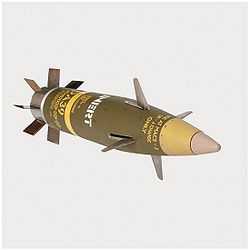M982 Excalibur
| M982 Excalibur | |
|---|---|
 | |
| Type | Guided artillery shell |
| Place of origin | Sweden/USA |
| Service history | |
| Used by | Sweden, U.S. Army, Canada |
| Production history | |
| Manufacturer | Bofors/Raytheon |
| Unit cost | US$53,620[1] (Increment Ib) |
| Specifications | |
| Weight | 48 kg (106 lb) [2] |
| Length | 99.6 cm (39.20 in) |
| Diameter | 155 mm |
|
| |
| Caliber | 155 mm |
| Effective firing range |
Increment Ia-1: 23 kilometres (14 mi) Increment Ia-2: 40 km (25 mi)[3] |
| Warhead | PBXN-9 |
|
| |
Guidance system | GPS plus inertial navigation |
The M982 Excalibur (previously XM982) is a 155 mm extended range guided artillery shell developed by Raytheon Missile Systems and BAE Systems Bofors. It is a GPS-guided munition capable of being used in close support situations within 150 metres (490 ft) of friendly troops.
Description
Excalibur was developed as a longer-ranged alternative to conventional artillery shells, with GPS guidance for improved accuracy.[4] Excalibur has a range of approximately 40 to 57 kilometres (25 to 35 mi) depending on configuration, with a circular error probable (CEP) of around 5 metres (16 ft) to 20 metres (66 ft).[5][6][7][8][9] The extended range is achieved through the use of folding glide fins, which allow the projectile to glide from the top of a ballistic arc towards the target.
The munition was co-developed by United States-based Raytheon Missile Systems (guidance system) and the Swedish BAE Systems Bofors (body, base, ballistics and payload).[4] Excalibur is used to minimize collateral damage, for targets beyond the range of standard munitions, for precise firing within 150 metres (490 ft) of friendly troops, or when firing in a straight line from the launching cannon is limited by terrain.[4][10]
Initial combat experience with Excalibur in Iraq in the summer of 2007 was highly successful, with 92% of rounds falling within 4 metres (13 ft) of the target. Its performance was so impressive that the U.S. Army planned to increase production to 150 rounds per month from the previous 18 rounds per month.[11][12] In 2012, Excalibur rounds reached new record ranges in combat of 36 kilometers.[13]
Excalibur is compatible with the British AS-90 SPG, Swedish Archer Artillery System, South African G6 howitzer and the United States M109A6 Paladin self-propelled 155 mm howitzer, M198 howitzer and M777 Lightweight Howitzer.
Variants
There are three versions of the system. Initial development effort was towards Increment I; Milestone C decisions will be made on Increment II and III in FY2013 with a demonstration of those capabilities by 2020.[3]
- Increment I has a unitary penetrating warhead for use against stationary targets.
- Increment Ia-1: Accelerated development, reduced range round. Entered service in 2007.[14]
- Increment Ia-2: Extended range round with resistance to GPS jamming
- Increment Ib: Full capability, reduced cost, mass-production round.
- Increment II "Smart" projectile for moving and time-sensitive targets.[3] May carry either 65 DPICM or two SADARM submunitions.[4]
- Increment III "Discriminating" projectile "to search, detect, and selectively engage individual vehicles by distinguishing specific target characteristics".[3]
- GPS/SAL: In June 2013, Raytheon initiated an internally funded program to upgrade the Excalibur Ib with a semi-active laser targeting capability. The SAL seeker will allow the shell to attack moving targets, attack targets that have re-positioned after firing, and change the impact point to avoid collateral damage. The GPS/INS Excalibur can be fired from 155 mm naval guns and can be downsized to fit in the body of a 127 mm (5.0 in) projectile.[15]
History

Excalibur started as a development program in 1992.[16] The Operational Requirements Document (ORD) of May 1997 called for 200,000 rounds of an unguided munition with increased range at an estimated cost of $4,000/round,[16] and Texas Instruments (now part of Raytheon) was awarded the initial EMD contract on 23 January 1998.[16] In November 2001 the volume was cut to 76,677 rounds and soon after this was further reduced to 61,483,[16] but the developers were encouraged by the Indian experience of using Russian Krasnopol guided shells against Pakistani bunkers in the Kargil War of 1999.[17] In March 2004 the program was merged with a Swedish/U.S. program to create Trajectory Correctable Munitions, reflected in a new ORD in September 2004 which removed the Dual-Purpose Improved Conventional Munition "cluster bomb" variant in favor of the discriminating munition variant.[16] Later that year the U.S. Army reduced its planned order to 30,000 rounds.[16] Low-rate production of 500 rounds was approved in May 2005 and Raytheon was awarded a contract to produce 165 rounds in June 2005,[16] worth $22.1 million.[18] In September of that year, the round was successfully demonstrated at Yuma Proving Ground, Arizona.[19] Raytheon was awarded a $42.7 million contract for production of 335 Excalibur projectiles and related test articles and services in June 2006 for that fiscal year.[20]
In August 2006, technical problems relating to environmental sensitivity and GPS signal lock were discovered, pushing the expected in-service date to Spring 2007.[14][21] Testing in September demonstrated an actual average CEP of 5m or better.[22]
Increment Ia-1 completed testing in early 2007 and in April that year the U.S. Army approved an Urgent Material Release to allow deployment to Iraq.[3] The Excalibur was first operationally fired in Iraq in May 2007.[23] Increment Ia-2 achieved a 40 km range in a live-fire demonstration in April 2007 and in July the Army Acquisition Executive approved the Milestone C decision for Ia-2 to enter low-rate production.[3]
In September 2008 both Raytheon and Alliant Techsystems were awarded competitive development contracts for Increment Ib mass production,[16] but Raytheon secured the final manufacturing contract in August 2010.[24] Test firings of Increment Ia-1 rounds in March 2009 revealed that the Honeywell inertial measurement unit was not up to standard, and it was replaced by a unit from Atlantic Inertial Systems.[16] In April 2010 the U.S. Army's planned order was cut further, from 30,000 rounds to 6,264, which increased the unit cost sufficiently that it triggered an investigation under the Nunn–McCurdy Amendment.[16] Normally a Nunn-McCurdy breach signals a program in trouble, but a 2012 RAND report concluded that the cost increases were caused by the cuts in procurement numbers, which in turn resulted from the improved accuracy of modern artillery, fewer shells were needed.[16]
The munition was developed with US$55.1 million in financial assistance from Sweden, which expected to receive service rounds in 2010. The Australian Army ordered US$40 million of Excalibur rounds in October 2007, an order revised in April 2008 to an estimated US$58 million.[25][26] In 2008 unit cost was US$85,000.[27] In FY2013 the U.S. Army would request 2287 Increment Ib rounds at a cost of US$122.629 million, or US$53,620/unit, but some of this funding may have been denied.[1] In December 2012, Raytheon received a $56.6 million contract for low-rate initial production of Excalibur Ib projectiles.[28] On 10 September 2013, Raytheon received a $54 million contract for a second lot of Excalibur Ib artillery rounds. The Excalibur Ib has improved reliability and lower unit cost than the previous Excalibur Ia-1 and Ia-2. At the time of the award, over 690 Excalibur projectiles had been fired in theater.[29]
In February 2012, a US Marine Corps M777 howitzer in Helmand province, Afghanistan, was used to fire a single Excalibur round that killed a group of insurgents at a Marine record range of 36 kilometres (22 mi).[30]
Operators
-
 Australia—pending FMS request
Australia—pending FMS request -
 Canada
Canada -
 Norway—pending FMS request
Norway—pending FMS request -
 Sweden
Sweden -
 United States Army and Marine Corps
United States Army and Marine Corps -
 Germany
Germany
See also
- M712 Copperhead
- XM1156 Precision Guidance Kit
- XM395 Precision Guided Mortar Munition
- Krasnopol (Weapon)
- Otobreda Vulcano
References
- ↑ 1.0 1.1 "House Report 112-493 - Department of Defense Appropriations Bill, 2013". United States Congress. 25 May 2012.
- ↑ "Development of the XM982 Excalibur Fuzing System". 2005-04-07.
- ↑ 3.0 3.1 3.2 3.3 3.4 3.5 "Excalibur XM982 Precision Engagement Projectiles". Office of the Director, Operational Test & Evaluation. 2007.
- ↑ 4.0 4.1 4.2 4.3 "XM982 Excalibur 155mm Precision Guided Extended Range Artillery Projectile". Globalsecurity.org. Retrieved 2007-05-27.
- ↑ http://www.dod.gov/pubs/foi/logistics_material_readiness/acq_bud_fin/SARs/DEC%202011%20SAR/EXCALIBUR%20-%20SAR%20-%2031%20DEC%202011.pdf
- ↑ "Raytheon Company: Excalibur". Raytheon.com. Retrieved 2012-07-06.
- ↑ Clark, Colin (2010-10-27). "Excalibur Use Rises In Afghanistan". DoD Buzz. Retrieved 2012-07-06.
- ↑ John Pike. "XM982 Excalibur 155mm Precision Guided Extended Range Artillery Projectile". Globalsecurity.org. Retrieved 2012-07-06.
- ↑ "Raytheon-BAE Systems Bofors' Excalibur Closer to Fielding". Spacewar.com. 2006-09-19. Retrieved 2012-07-06.
- ↑ "Big Guns". MichaelYon.com. Retrieved 2010-06-10.
- ↑ Aviation Week & Space Technology, 2007-09-03, page 20
- ↑ Swedish missile among U.S. Army's favourites in Iraq The Local, 2008-08-22
- ↑ "US Marines fire Excalibur from record range in Afghanistan." Space War, 13 June 2012.
- ↑ 14.0 14.1 Strategy Page - Excalibur Delayed Again
- ↑ Raytheon Unveils Excalibur with Dual GPS and Semi-Active Laser Guidance - Deagel.com, 20 June 2013
- ↑ 16.0 16.1 16.2 16.3 16.4 16.5 16.6 16.7 16.8 16.9 16.10 Blickstein, Irv; Drezner, Jeffrey A.; et al (2012), Root Cause Analyses of Nunn-McCurdy Breaches, Volume 2 - Excalibur Artillery Projectile and the Navy Enterprise Resource Planning Program, with an Approach to Analyzing Complexity and Risk, RAND Corporation, ISBN 9780833076434
- ↑ ""One Shot, One Kill" May Not Be Worth It". StrategyWorld.com. 7 February 2006.
- ↑ "Raytheon Receives $22.1M to Deliver Excalibur GPS Shells Ahead of Schedule". Defense Industry Daily. 30 June 2005.
- ↑ Troops could have new Picatinny-developed smart artillery munition by March - RDECOM Magazine
- ↑ XM982 Excalibur - Deagel
- ↑ Strategy Page - Excalibur Freeze Out
- ↑ Successful Safety Testing of GPS-Guided Artillery Projectile Puts Raytheon-BAE Systems Bofors' Excalibur Closer to Fielding - Raytheon
- ↑ "America’s First Team first-ever to fire Excalibur precision munition in combat".
- ↑ Brannen, Kate (27 August 2010). "Raytheon Beats ATK to Win Excalibur Job".
- ↑ Defense Security Cooperation Agency, 1 October 2007
- ↑ Defense Security Cooperation Agency, April 2008
- ↑ Cannot Get Enough Excalibur
- ↑ Raytheon's new precision artillery ready for low-rate initial production - Raytheon press release, 20 February 2013
- ↑ Raytheon receives $54 million Excalibur Ib order - Shephardmedia.com, 12 September 2013
- ↑ Lamothe, Dan (30 June 2012). "Long shot: Artillery battery sets lethal record". Marine Corps Times. Retrieved 11 October 2013.
- Jane's Ammunition Handbook 2003–2004
Further reading
- 2012 RAND report goes into detail on the progress of the project
External links
| Wikimedia Commons has media related to XM982 Excalibur. |
- Excalibur Precision Guided Extended Range Artillery Projectile — Raytheon
- Excalibur — BAE Systems Bofors
- Excalibur XM982 — Defense Update
- Video of Excalibur test — Metacafe
- Missile Systems - Precision Guided Projectiles — Raytheon
- Excalibur round used for the first time in Afghanistan